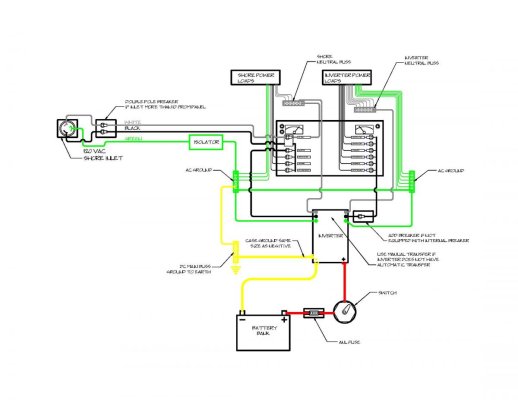My boat did not trip the pedastal breakers at any marinas when we did the Loop last year. When we pulled into Brunswick Landing Marina (GA), before being allowed to plug in, the dockmaster asked if we had had any problems at other marinas. But, for us, we would have if, before leaving, I had not discovered that, sometime in the past for some unknown reason, a jumper had been installed connecting the neutral (white) bus bar to the safety (green) bus bar.
Three years ago, based on some very sage advice from this forum and well before this became a common problem, I started looking around. There it was, the jumper, plain as day. Five minutes looking, five minutes to remove it. So, in my case I did not need an ABYC electrician but it was blind luck that an obvious problem was plain to see. For most folks getting an electrician is wise.
For those here who are more knowledgable than I, isn't the test for this problem to check the level of current on the hot wire as compared to the neutral and safety wires with a clamp-on meter? Shouldn't the safety wire show current of less than a certain amount? I don't know the answer.
I would suggest going back and re-checking because it's possible that you solved one problem, yet created another one in the process.
The neutral and ground do need to be bonded, but it's a questions of WHEN and WHERE. And to further complicate things, it varies from boat to boat depending on what sorts of power generation equipment you have. Plus there are lots of ways to solve the problem.
Here's how the grounding should be set up on a boat:
- The simple summary rule is that the always needs to be
one, and
only one, neutral to ground connection. Boat builders and AC equipment installers have always been sloppy about this, and the rise of RCDs is now calling them out on past bad practices.
- When on shore power, the neutral/ground bond is in the shore-side power system, and your boat should NOT bond neutral and ground. Many boats, like yours, have an on-board ground and it is causing RCDs to trip in new marinas. But in many cases, you disable an important safety feature if you just remove that bonding wire. Read on to see why.
- When using an on-board source of power, like a generator or inverter, you need to bond neutral and ground. But since you are not plugged into shore power and can't utilize that bonding point, the bonding needs to be done on-board the boat. This is typically done right at the generator or inverter, or at a central point in your power system. But this on-board bonding needs to be in place when using the generator or inverter, but disconnected when using shore power. This is where it gets tricky. You can see that the need for this, and how it needs to work will vary based on whether you have an inverter or generator.
- Some inverters have a neutral to ground bond that is switched along with the inverter's internal transfer switch. That will solve the problem for the inverter, but I have heard of issues where the switch isn't fast enough and still trips RCDs. And you need to keep in mind that you might have your generator running with or without the inverter, so you need to look at all possible combinations on your boat.
- Neutral/ground bonding can also be handled in the power selector switches where you select between generator or shore power. If the switch breaks neutral as well as the power lines, you can bond on-board on the generator neutral, and not on the shore neutral. That way the correct bonding follows the power selector switch.



